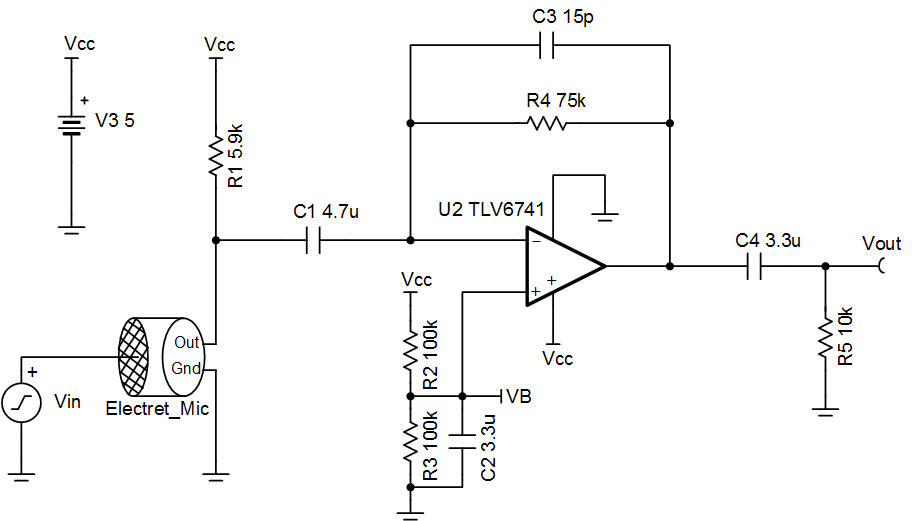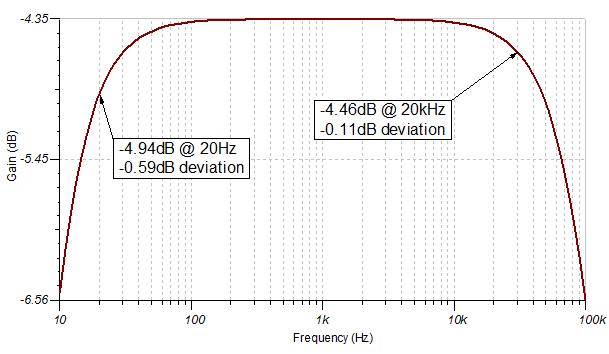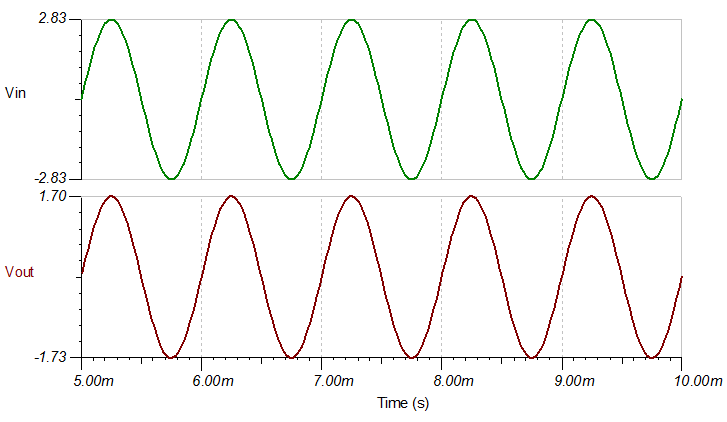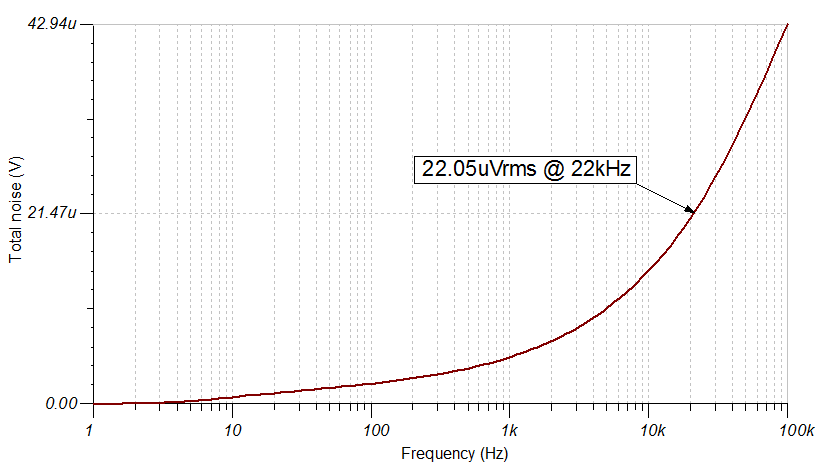SBOA291 december 2018 OPA172 , OPA192 , TLV6741
Design Goals
| Input pressure (Max) | Output Voltage (Max) | Supply | Frequency Response Deviation | ||
|---|---|---|---|---|---|
| 100 dB SPL(2Pa) | 1.228 Vrms | Vcc | Vee | At 20 Hz | At 20 kHz |
| 5 V | 0 V | –0.5 dB | –0.1 dB | ||
Design Description
This circuit uses an op amp in a transimpedance amplifier configuration to convert the output current from an electret capsule microphone into an output voltage. The common mode voltage of this circuit is constant and set to mid–supply eliminating any input–stage cross over distortion.

Design Notes
1. Use the op amp in the linear output operating range, which is usually specified under the AOL test conditions.
2. Use low–K capacitors (tantalum, C0G, and so forth) and thin film resistors help to decrease distortion.
3. Use a battery to power this circuit to eliminate distortion caused by switching power supplies.
4. Use low value resistors and low noise op amp to achieve high performance low noise designs.
5. The voltage connected to R1 to bias the microphone does not have to match the supply voltage of the op amp. Using a larger microphone bias voltage allows for a larger value or R1 which decreases the noise gain of the op amp circuit while still maintaining normal operation of the microphone.
6. Capacitor C1 should be large enough that its impedance is much less than resistor R1 at audio frequency. Pay attention to the signal polarity when using tantalum capacitors.
Design Steps
The following microphone is chosen as an example to design this circuit.
Microphone parameter Value Sensitivity at 94 dB SPL (1 Pa) –35 ± 4 dBV Current Consumption (Max) 0.5 mA Impedance 2.2 kΩ Standard Operating Voltage 2 Vdc - Convert the sensitivity to volts per Pascal.
- Convert volts per Pascal to current per Pascal.
- Max output current occurs at max sound pressure level of 2Pa.
- Calculate the value of resistor R4 to set the gain
- Calculate the value for the bias resistor R1. In the following equation, Vmic is the standard operating voltage of the microphone
- Calculate the high frequency pole according to the
allowed deviation at 20 kHz. In the following equation, G_pole1 is the gain at
frequency f.
- Calculate C3 based on the pole frequency calculated in step 6.
- Calculate the corner frequency at low frequency
according to the allowed deviation at 20 Hz. In the following equation, G_pole2
is the gain contributed by each pole at frequency f respectively. There
are two poles, so divided by two.
- Calculate the input capacitor C1 based on the cut off frequency calculated in step 8.
- Assuming the output load
R5 is 10 kΩ, calculate the output capacitor C4 based
on the cut off frequency calculated in step 8.
- Set the amplifier input common mode voltage to
mid–supply voltage. Select R2 and R3 as 100 kΩ. The
equivalent resistance equals to the parallel combination of the two resistors:
- Calculate the capacitor C2 to filter the power supply and resistor noise. Set the cutoff frequency to 1 Hz.
Design Simulations
AC Simulation Results

Transient Simulation Results
The input voltage represents the SPL of an input signal to the microphone. A 2 Vrms input signal represents 2 Pascal.

Noise Simulation Results
The following simulation results show 22.39 µVrms of noise at 22 kHz. The noise is measured at a bandwidth of 22 kHz to represent the measured noise using an audio analyzer with the bandwidth set to 22 kHz.

References:
- Analog Engineer's Circuit Cookbooks
- SPICE Simulation File SBOC526
- TI Precision Designs TIPD181
- TI Precision Labs
Design Featured Op Amp
| TLV6741 | |
|---|---|
| Vss | 1.8 V to 5.5 V |
| VinCM | Vee to Vcc–1.2 V |
| Vout | Rail–to–rail |
| Vos | 150 µV |
| Iq | 890 µA/Ch |
| Ib | 10 pA |
| UGBW | 10 MHz |
| SR | 4.75 V/µs |
| #Channels | 1 |
| TLV6741 | |
Design Alternate Op Amp